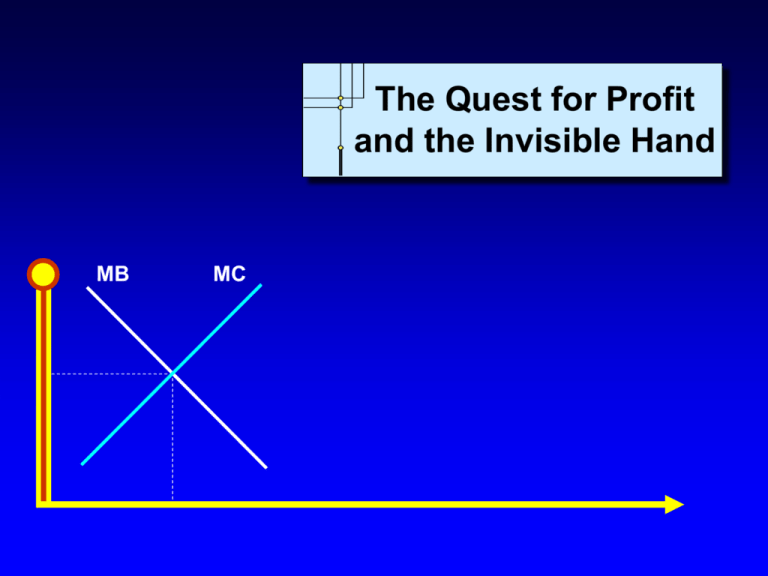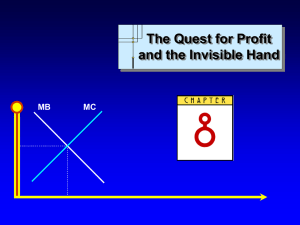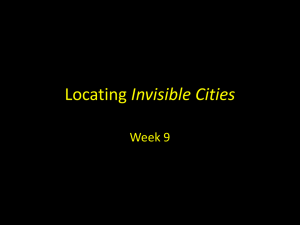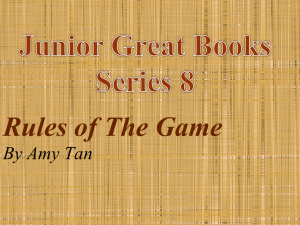
The Quest for Profit
and the Invisible Hand
MB
MC
MB MC
The Central Role
of Economic Profit
According to mainstream economists
People are rational and motivated by self-interest.
“homogenous
globules of desire”
But empirical research shows this assumption rarely
holds (e.g. behavioral economics)
“Sales Are Colossal, Shares Are Soaring. All Amazon Is
Missing Is a Profit”
The goal of profit maximization will serve society’s
collective interest.
but
only in perfect markets
and only if we believe that maximizing monetary value is
in society’s collective interest and the underlying
distribution of wealth and resources is desirable.m
Copyright c 2004 by The McGraw-Hill
Companies, Inc. All rights reserved.
Chapter 8: The Quest for Profit and the Invisible Hand
Slide 2
MB MC
Three Types of Profit: 1
Accounting Profit = total revenue –
explicit costs (actual payments made to
factors of production)
e.g. money a farmer gets for selling his
milk, minus wages to hired hand, interest
on loan for purchase of new tractor, costs
of fuel, etc.
What is left out here?
Copyright c 2004 by The McGraw-Hill
Companies, Inc. All rights reserved.
Chapter 8: The Quest for Profit and the Invisible Hand
Slide 3
MB MC
Three Types of Profit: 2
Economic Profit = total revenue – explicit
costs – implicit costs (opportunity cost of the
resources supplied by the firm’s owners)
E.g. also subtract money farmer could have made
working elsewhere, money he could have made
renting his land to someone else, etc.
Payments to factors of production (explicit
and implicit)
Payment to labor (human capital) = wage
to land (natural capital) = rent (unearned income)
to capitalists (finance and machinery/built capital)
= interest
Copyright c 2004 by The McGraw-Hill
Companies, Inc. All rights reserved.
Chapter 8: The Quest for Profit and the Invisible Hand
Slide 4
MB MC
Three Types of Profit: 3
Normal Profit
= accounting profit – economic profit
= fair payment to implicit costs
i.e. normal profit occurs when all factors
of production, owned and unowned,
earn their expected returns
E.g. Farmer earns as much farming as he
would working elsewhere and renting his
land to a neighbor.
Copyright c 2004 by The McGraw-Hill
Companies, Inc. All rights reserved.
Chapter 8: The Quest for Profit and the Invisible Hand
Slide 5
MB MC
The Central Role
of Economic Profit
Calculating Profit
Suppose a firm has the following:
TR
[Total Revenue] = $400,000
Explicit costs (salaries) = $250,000/yr
Machinery and other equipment with a resale
value of $1 million (implicit cost = returns to
capital = interest, i.e. the amount of money he
would earn by investing the $1 million
elsewhere)
Copyright c 2004 by The McGraw-Hill
Companies, Inc. All rights reserved.
Chapter 8: The Quest for Profit and the Invisible Hand
Slide 6
MB MC
The Central Role
of Economic Profit
Calculating Profit
Accounting Profit
$400,000(TR)
- $250,000 (explicit costs) =
$150,000
Copyright c 2004 by The McGraw-Hill
Companies, Inc. All rights reserved.
Chapter 8: The Quest for Profit and the Invisible Hand
Slide 7
MB MC
The Central Role
of Economic Profit
Calculating Profit
To calculate economic profits, assume
Annual
interest on typical investment = 10%
[Then the $1 million spent on equipment could
have earned $100,000/yr had it been invested]
Economic Profit
$400,000
(TR) - $250,000 (explicit cost) $100,000 (implicit cost) = $50,000
i.e. profits above and beyond a fair return to the
factors of production
Copyright c 2004 by The McGraw-Hill
Companies, Inc. All rights reserved.
Chapter 8: The Quest for Profit and the Invisible Hand
Slide 8
MB MC
The Central Role
of Economic Profit
Calculating Profit
Normal Profit
Profit ($150,000/yr) – Economic Profit
($50,000/yr) = $100,000/yr
Normal profit is a fair return on the factors of
production you own, in this case the $1 million in
capital
Accounting
Copyright c 2004 by The McGraw-Hill
Companies, Inc. All rights reserved.
Chapter 8: The Quest for Profit and the Invisible Hand
Slide 9
MB MC
The Difference Between
Accounting Profit and Economic Profit
Total
revenue
Explicit
costs
Explicit
costs
Accounting
profit
Normal profit =
opportunity cost of
resources supplied
by owners of firm
Copyright c 2004 by The McGraw-Hill
Companies, Inc. All rights reserved.
Chapter 8: The Quest for Profit and the Invisible Hand
Economic
profit
Slide 10
MB MC
Why are the distinctions important?
Example
Should a Vermont farmer stay in the farming
business?
He should stay as long as he can pay for all
his hired factors of production (e.g. hired
workers, rented machinery), makes as high a
return on his labor as he would working
elsewhere, and makes as much on his land
as he would if he rented it, or else sold it and
invested the profits.
Copyright c 2004 by The McGraw-Hill
Companies, Inc. All rights reserved.
Chapter 8: The Quest for Profit and the Invisible Hand
Slide 11
MB MC
Practice at home:
You are a small business owner who
owns the land and capital required for
your business. You bring in $500,000
per year in revenue, and pay out
$250,000 per year for the labor and raw
materials you require.
Copyright c 2004 by The McGraw-Hill
Companies, Inc. All rights reserved.
MB MC
The difference between your total
revenue and the $250,000 you pay for
factors of production represents:
A.
B.
C.
D.
E.
Implicit costs
Economic profits
Normal profits
Accounting profits
Explicit costs
Copyright c 2004 by The McGraw-Hill
Companies, Inc. All rights reserved.
MB MC
The potential return on your land,
capital and labor, if allocated towards
the best alternative activity, represents:
A.
B.
C.
D.
E.
Implicit costs
Economic profits
Normal profits
Accounting profits
Explicit costs
Copyright c 2004 by The McGraw-Hill
Companies, Inc. All rights reserved.
MB MC
The different between your accounting
profits and the potential return on your
land, capital and labor represent:
A.
B.
C.
D.
E.
Implicit costs
Economic profits
Normal profits
Accounting profits
Explicit costs
Copyright c 2004 by The McGraw-Hill
Companies, Inc. All rights reserved.
MB MC
The Central Role
of Economic Profit
A Review
Accounting Profit = TR – explicit costs,
Economic Profit = TR – explicit and
implicit costs
Normal profit = a fair return on the factors
of production; economic profits = 0
To remain in business in the long run,
economic profits must be greater than or
equal to 0 (zero) i.e. P>=min ATC.
Copyright c 2004 by The McGraw-Hill
Companies, Inc. All rights reserved.
Chapter 8: The Quest for Profit and the Invisible Hand
Slide 16
MB MC
Two Functions of Price: 1
The rationing function of price
To distribute scarce goods to those
consumers who value them most highly
BUT as economists determine value, you
can only value something if you have
money.
Amerindians
in the Amazon do not value the
forest
Poor people do not value life saving medicine,
e.g. eflornithine
There is no role for ethical, moral or social
values
Copyright c 2004 by The McGraw-Hill
Companies, Inc. All rights reserved.
Chapter 8: The Quest for Profit and the Invisible Hand
Slide 17
MB MC
Two Functions of Price
The allocative function of price
To direct resources away from
overcrowded markets and toward markets
that are underserved
BUT, from the economists perspective,
markets in life saving medicines for poor
people are overcrowded, while markets for
facial hair loss formulas for rich people are
underserved.
Copyright c 2004 by The McGraw-Hill
Companies, Inc. All rights reserved.
Chapter 8: The Quest for Profit and the Invisible Hand
Slide 18
MB MC
Copyright c 2004 by The McGraw-Hill
Companies, Inc. All rights reserved.
Chapter 8: The Quest for Profit and the Invisible Hand
Slide 19
MB MC
The Invisible Hand Theory
Resources are allocated across firms to produce the
most efficient (i.e. profitable) possible mix of goods
and services (allocative function)
Goods and services are efficiently (i.e. maximizing
monetary value) allocated across consumers
(rationing function)
Inputs will go to those producers who can pay the most for
them (i.e. who can create the highest valued products from
them)
Outputs will go to those consumers who value them the most
(i.e. who can pay the most)
Markets balance possibility with desirability
Copyright c 2004 by The McGraw-Hill
Companies, Inc. All rights reserved.
Chapter 8: The Quest for Profit and the Invisible Hand
Slide 20
MB MC
Responses to Profits and Losses
Markets with firms earning economic
profits will attract resources.
Markets where firms are experiencing
economic losses tend to lose resources.
Shifts in demand will raise or lower
prices, hence profits, leading to entry or
exit of firms, returning prices to their
‘fair’ level
GRAPHS ON BOARD
Copyright c 2004 by The McGraw-Hill
Companies, Inc. All rights reserved.
Chapter 8: The Quest for Profit and the Invisible Hand
Slide 21
MB MC
This graph depicts a situation in which:
A. Economic profits will allocate more resources to this industry
B. Economic losses will lead firms to leave this industry
C. An industry in which firms are earning normal profits
D. An industry in which firms are making short run losses
E. An industry in which firms are making long run losses
Copyright c 2004 by The McGraw-Hill
Companies, Inc. All rights reserved.
MB MC
Economic Profit in the
Short Run in the Corn Market
MC
S
4.00
D
65
Market Quantity (millions of
bushels/year)
Price ($/bushel)
Price ($/bushel)
ATC
Price
4.00
2.40
130
Firm Quantity (1000s of
bushels/year)
Market price of $4/bushel produces economic profits
Copyright c 2004 by The McGraw-Hill
Companies, Inc. All rights reserved.
Chapter 8: The Quest for Profit and the Invisible Hand
Slide 23
MB MC
The Effect of Entry on
Price and Economic Profit
S
MC
S
4.00
3.00
D
65 95
Market Quantity (millions of
bushels/year)
ATC
Price ($/bushel)
Price ($/bushel)
’
Economic profit
declines as price
falls
4.00
3.00
Price
120 130
Firm Quantity (1000s of
bushels/year)
Economic profits attract firms, reducing prices and profits
Copyright c 2004 by The McGraw-Hill
Companies, Inc. All rights reserved.
Chapter 8: The Quest for Profit and the Invisible Hand
Slide 24
MB MC
Equilibrium when Entry Ceases
MC
S
2.00
Price ($/bushel)
Price ($/bushel)
ATC
Price
2.00
D
115
Quantity (millions of
bushels/year)
90
Quantity (1000s of
bushels/year)
Entry of firms continues until all firms earn a normal profit
Copyright c 2004 by The McGraw-Hill
Companies, Inc. All rights reserved.
Chapter 8: The Quest for Profit and the Invisible Hand
Slide 25
MB MC
A Short-Run Economic
Loss in the Corn Market
MC
S
1.50
D
60
Quantity (millions of
bushels/year)
Price ($/bushel)
Price ($/bushel)
Economic loss
= $21,000/year
2.10
1.50
Price
70 90
Quantity (1000s of
bushels/year)
Prices below minimum ATC results in economic losses.
Copyright c 2004 by The McGraw-Hill
Companies, Inc. All rights reserved.
Chapter 8: The Quest for Profit and the Invisible Hand
Slide 26
ATC
MB MC
Equilibrium when Exit Ceases
S
’
S
2.00
1.50
D
40 60
Quantity (millions of
bushels/year)
Price ($/bushel)
Price ($/bushel)
MC
2.00
1.50
ATC
Price
90
Quantity (1000s of
bushels/year)
The departure of firms from the industry increases the market price
Copyright c 2004 by The McGraw-Hill
Companies, Inc. All rights reserved.
Chapter 8: The Quest for Profit and the Invisible Hand
Slide 27
MB MC
Efficiency & community development
How does the cost structure of Wallmart compare with the little store on
Church street?
What happens when a Wall-mart comes
to town?
Copyright c 2004 by The McGraw-Hill
Companies, Inc. All rights reserved.
Chapter 8: The Quest for Profit and the Invisible Hand
Slide 28
MB MC
Communities, again
What happens when all other stores
close?
Does this serve society’s collective
interest?
Copyright c 2004 by The McGraw-Hill
Companies, Inc. All rights reserved.
Chapter 8: The Quest for Profit and the Invisible Hand
Slide 29
MB MC
The Invisible Hand Theory
In the long-run, in a competitive market, all
firms will tend to earn zero economic profits.
Consumer gets the good as cheaply as possible
But remember, normal profits cover all the costs of
production
Zero economic profits are the consequence of
price movements caused by the entry and exit of
firms trying to maximize economic profits.
Copyright c 2004 by The McGraw-Hill
Companies, Inc. All rights reserved.
Chapter 8: The Quest for Profit and the Invisible Hand
Slide 30
MB MC
Long-Run Equilibrium in a Corn
Market with Constant Long-Run Average Cost
Is this realistic? What factors of production are fixed in th long run?
MC
LMC
=LAC
=1.00
S
D
Quantity (millions of
bushels/year)
Price ($/bushel)
Price ($/bushel)
ATC
1.00
Price
90
Quantity (1000s of
bushels/year)
Similar ATC curves allow the industry to supply
any output at a price equal to minimum ATC.
Copyright c 2004 by The McGraw-Hill
Companies, Inc. All rights reserved.
Chapter 8: The Quest for Profit and the Invisible Hand
Slide 31
MB MC
Two Attractive Features
The market outcome is efficient in the
long run.
P = MC= min ATC
The market is fair.
The price the buyers pay is no higher than
the cost incurred by sellers.
The cost includes a normal profit.
Normal profits include payments to all
factors of production, including a CEO
making 100 million a year.
Copyright c 2004 by The McGraw-Hill
Companies, Inc. All rights reserved.
Chapter 8: The Quest for Profit and the Invisible Hand
Slide 32
MB MC
The Invisible Hand in Action
The Invisible Hand and Cost-Saving
Innovations
In a competitive market
Firms
are price takers
P = MC
Zero economic profits exist in the long run
Question
Why do these firms have an incentive to
introduce cost-saving innovations?
Copyright c 2004 by The McGraw-Hill
Companies, Inc. All rights reserved.
Chapter 8: The Quest for Profit and the Invisible Hand
Slide 33
MB MC
Free Entry and Exit
Free entry and exit must exist for the
allocative function of price to operate
Barriers to entry can be caused by legal
constraints and unique market characteristics
Patents and copyrights
Medicine
prices in US and Canada
Textbook prices in US and Europe
Compatibility between products
Firm size
Quotas
Copyright c 2004 by The McGraw-Hill
Companies, Inc. All rights reserved.
Chapter 8: The Quest for Profit and the Invisible Hand
Slide 34
MB MC
Economic Rent
Versus Economic Profit
Economic Rent
That part of a payment for a factor of
production that exceeds the owner’s
reservation price
Think
about land, fossil fuels, etc.
Market forces will not push economic rent
to zero because inputs cannot be
replicated easily
But
Copyright c 2004 by The McGraw-Hill
Companies, Inc. All rights reserved.
taxes can push it to zero
Chapter 8: The Quest for Profit and the Invisible Hand
Slide 35
MB MC
Economic Rent
Versus Economic Profit
An absentee landowner rents farmland to a
corn farmer for $30,000 yr.
Farmer generates an income (TR-explicit
costs) of $30,000 yr (normal profit)
A new government subsidy for ethanol
increases revenue from the farmland by
$30,000 year
What happens to the rent, the farmer’s
income, and the price of the land?
Copyright c 2004 by The McGraw-Hill
Companies, Inc. All rights reserved.
Chapter 8: The Quest for Profit and the Invisible Hand
Slide 36
MB MC
Economic Rent
Versus Economic Profit
An absentee landowner rents farmland
to a corn farmer for $30,000 yr.
Famer generates an income of $30,000
yr (normal profit)
The government raises taxes on the
land by $30,000 year
What happens to the rent, the farmer’s
income, and the price of the land?
Copyright c 2004 by The McGraw-Hill
Companies, Inc. All rights reserved.
Chapter 8: The Quest for Profit and the Invisible Hand
Slide 37
MB MC
Landowner cannot pass on tax
60K
tax?
excess supply
30K
tax
Copyright c 2004 by The McGraw-Hill
Companies, Inc. All rights reserved.
demand
MB MC
The Invisible Hand in Action
The Invisible Hand in Antipoverty
Programs, e.g. the green revolution
How will an irrigation project affect the
incomes of poor farmers who rent land?
Copyright c 2004 by The McGraw-Hill
Companies, Inc. All rights reserved.
Chapter 8: The Quest for Profit and the Invisible Hand
Slide 39
MB MC
The Invisible Hand in Action
Assume
An unskilled worker has two job choices
Textile
worker
Renting land to grow rice
A state funded irrigation program doubles
output without changing the market price.
What happens to income of landless?
What happens to price of land?
Who benefits?
Copyright c 2004 by The McGraw-Hill
Companies, Inc. All rights reserved.
Chapter 8: The Quest for Profit and the Invisible Hand
Slide 40







